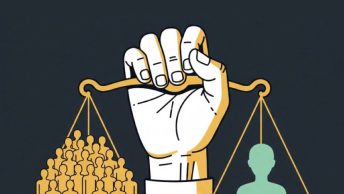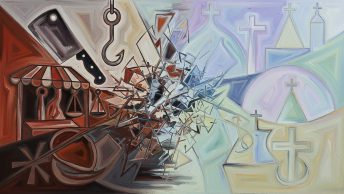Lynching is not a phenomenon of just one nation or one society. It is universal, multifarious, undemocratic and unjustifiable. It is an act of power which unfolds through indiscriminate violence perpetrated on self-chosen targets by a motley crowd of civil society actors. These actors claim to be above the law or even transcend the law as a means of social control. Lynching ought to be controlled by the law very severely. It also merits control by other means of social action; merely enacting a law could just end up as an escape hatch. Adoption of a law to address a social problem ought not to be used as a mere ‘escape-hatch’. The resolution of a social problem merits adoption of means other than legal which lies in political and social fields.
Emmanuel Lévinas in his book ‘On Escape’ details the moral logic of why we must escape the idea of ‘Being’ and move to ‘beings’ – the eternal dialectic of envisioning and escaping. We here play with the idea of Lévinas – ‘otherwise than being’ – and say that one must escape the condition of being a perpetrator, a victim, and a witness of lynching. In other words: How to escape lynching as a spectacle of power is a very important question.
I speak of lynching in a rather limited sense: in a legal sense. These acts need to be classified. The first one speaks, for example, of fatal and non-fatal use of force. Some lynching acts are killings (murders or manslaughter); other result in assault or assassination of various bodily parts (which criminal law calls grievous hurts). Second, all are public acts and therefore involve humiliation and objectification, often in the media (including social media glare). Third, some are systemic and others are random, or in my terms ‘structural’ or ‘episodic.’ Fourth, these are often, even always, acts of brute domination and power; as such they are rendered socially invisible by low or nil prosecution or punishment. Fifth, the acts equates governance with lynching when the State itself shows a high degree of tolerance or indifference. Sixth, most of the time we do not know the effect lynching acts have on the perpetrator but we do know the immediate and long-term impact on lynched persons, their families, community, and other webs of belonging. The overall coarsening of public cultures and recourse to violence by anonymous mobs is a related consequence of growth in the belief that lynching is handmaiden of law and policy enforcement and consists in serial acts of social pedagogy.
A full definition of lynching would be socially directed targeting of people or directed killing or infliction of violence against a few persons. In fact, all of our law is targeted violence. The Indian Penal Code, 1860 is legally targeted violence, but what differentiates lynching is that it is a targeted ‘extra-legal’ violence. One may wonder whether there is a continuum or a separation between legal and extra-legal infliction of violence. This is a very important question in jurisprudence, which can partly be understood by the allusion of threshold, which shapes the perception the inside and the outside of borders and boundaries, and structures zones of indeterminacy.
In India, there is virtually no academic writing on lynching as a phenomenon except for a few newspaper articles, in contrast to books which I indicate below. These indicate the histories, itineraries, and ‘justifications’/ ‘de- justifications’ of lynching and ways to combat and control such behaviour.
Lynching against the untouchables is a several millennia old phenomenon in India- probably the oldest anywhere. Lynching and social boycott go hand-in-hand in the untouchable experience. Perhaps, some data features in the atrocities statistics; the same may be said about scheduled tribes; if so, the data needs to be disaggregated. We do not know much about medieval or colonial practices of lynching, nor do we have much any statistical data in the post-colonial period. Although episodes of communal lynching which have recently made cruel news, disaggregated data on this is simply not available. Perhaps, we can construct these according to caste and religion as per the offences already in the books – such as simple or grievous hurt, assault, rape and harassment, attempt to murder etc. The National Crimes Bureau should take an autonomous data leadership on this.
An American law professor once told me as to how he changed his classroom instruction which previously began with Marbury v. Madison (1803) to now starting with the poison of Dredd Scott v. Sandford (1857), a memoir of how America was born in slavery. The Indian history is too rooted with pervasive inequality. Perhaps, we have lot more justification to transform constitutional law into people’s law, a social pedagogy for freedom and equality, and justice.
The Need for a Law?
The United Progressive Alliance came up with a bill to prevent and punish communally targeted killing of and violence against people. Whether the bill misunderstood the roots of the problem, and rather than substantively empowering existing authorities and holding the perpetrators responsible opted for cosmetic overhauls and only went on to create more bureaucratic authorities is a severely contested arena. When the Bill was debated in the Lok Sabha, the opposition objected to it for addressing killings only on communal grounds. Finally, the bill was dropped and I revived this bill in July 21, 2018 in an article in the Indian Express called “Re-arming the Law”. There, I make the argument that there need not be any new legislative endeavour from square one to draft a new law. This draft bill could be taken up again and passed. There is also a private-member’s bill pending on this and most recently, the Supreme Court of India speaking through the Chief Justice also called upon the government to recognise the need to bring in a law against lynching.
It would be erroneous to say that lynching acts are wholly political acts. Our memories cannot be too short. Intellectual lynching also occurs when we act as bystanders to this violence and pursue academic or scientific enquiries, which we regard as more important. Teachers, researchers, and learners have an important role to pay in understating this phenomenon and to finds ways of social exit from these.
The Supreme Court has come up with these antimonies: mobocracy versus democracy, order versus anarchy, and legal help versus self-help. Every time the legislature enacts a law, it replenishes its sovereignty as the mouthpiece of the people to make laws. This act of law-making puts the state on a higher pedestal raising it above any other civil or social collectivisation. I am worried about appropriation of the tool of lynching to augment state power. Lynching is an unqualified bad.
I agree with Lon L. Fuller’s conception of the law when he says that law is an enterprise of subjecting human behaviour to norms. Law-making, therefore, is a normative exercise. It is a very workable definition. Hence, the law against lynching must target targeted killings. The targeting could be at the touchstone of ethnicity or caste, community, or religion. The Constitution does not contemplate the return of what Babashaeb Ambedkar called rejected and dejected ‘broken people’ who may be considered by some unruly mobs as lynch-worthy.
In cases of xenophobic and communal lynching, one person’s body becomes a site of history. The person is not lynched for his or her own conduct, but for the past conduct of others. In allowing this to happen the administration and the law proceeds to become a programme of revenge.

There is a pervasive erosion of belief in the law; a phenomenon that is represented by the concerns raised by sexual harassment movements where women contend that the due process of law becomes an obstacle to justice. Naming and shaming of people hinders our march towards the rule of law. Inter-generational justice seems to some to require that we punish even a wrong person to do justice towards those belonging to the past generations. I also worry about the underlying belief held by some feminist scholars that the law ought to be rejected. The same belief is held at the very opposite end of the spectrum: by terrorist movements. Of course, comparing feminist movements with terrorism is illogical and undesirable. Globally, the number of groupings that do not believe in the law has increased; does this trend have had a concomitant impact on the rise in the number of episodes of lynching? This question needs to be studied closely as well as the other social/global determinants of lynching. The social movements heralded by these groups tend to limit their focus only to the immediate situation. Whatever may be said of the situation in the past, lynching cannot be purely regarded as an indigenous or native phenomenon.
We live in a world where self-help, naming and shaming, and violence against innocent people has become the norm. With this backdrop, we have come to live in a world where at times, we tend to justify some instances of lynching as being legitimate. Therefore, what we see is that a new theology is emerging. Recently, a politician perhaps trying to distinguish between “good lynching” and “bad lynching” argued that good lynching is helping and aiding the state to give effect to law. This theology of there being some cases of lynching being good is very problematic. Who decides what is good and what is bad? Will there be some thresholds for that which is good? May anti-law be invoked to help the law? These are questions for us to consider.
Thinking about other forms of Lynching
We must also worry about what I would like to call “legal” lynching. What happens in encounter-killings? We have police officers being referred to as “encounter-specialists”. Killing of another human being has started to be recognised as entailing the performance of a skilled enterprise. Further, such skilful mastery in ending lives is considered to foster law and order and promote national integration and sometimes, even development. Legal lynching implies that the law by itself has elements of lynch justice. There are many examples of laws which legalise lynching. Hudood laws as recognised in Islam and implemented in Pakistan during Zia-ul-Haq’s times speak through the vocabulary of an eye for an eye, a tooth for a tooth. They even permit amputation of limbs even for the commission of petty crimes.
Donald Trump, the President of the United States separated infants from their parents in Mexican camps. If this is not legal lynching, then what is it? It also entails the making of lynching assumptions. Indeed, we make several lynching assumptions in courts of law. Even assuming that deportation of those illegal migrants is right in law, can you still separate young children from her mother? So, there are legally justified forms of lynching. According to me, even capital punishments are a form of legal lynching.
Then, there is something called “symbolic” lynching. For example, can we say that judicial delays symbolise a form of lynching not prima facie apparent? Despite there being no visible form of violence being inflicted, delay can make an innocent party suffer, often violently also. Inter-generational justice is best achieved when a case started by grand-mother is decided in favour of her grand-daughter! A judicial process that spans three generations also lynches human soul. We know of the stories that abound judicial appointments, special courts, how half of the total number of posts for judges are lying vacant. We know that the judiciary does not have its own money; according to me, the charge of court fees is being “misappropriated” by the executive wing of the government. Law does not have any source of investment by itself. Hence, the very ways in which our legal system works also symbolises a discrete form of lynching.
Lynching can be looked at from three perspectives. One from the point-of-view of the perpetrator, and another from the standpoint of the victim, and third from the viewpoint of the bystanders and onlookers. From the standpoint of the victim, lynching can be defined as a collage of firstly violence, secondly humiliation, thirdly, causing injury to the future generations as providing them with precedent to justify self-help, and fourthly, serial genocide. India has ratified the Genocide Convention, but has not enacted a law to implement it. The Convention imposes an obligation upon those states which ratify it to take steps to penalise and prevent genocide. This duty to prevent genocide is what should be properly understood in the context of lynching. Lynching is the perpetration of violence in a group form. It is a collective offence against a person on the basis of the latter’s membership or affiliation to another group. I also say that lynching attracts some elements of a crime against humanity.
The proposal to have a special law to deal with lynching is mired by problems.
First, the law cannot take a double standard against what it might want to treat as good lynching as against bad lynching. Should we have some normative supposition in the law to aid groups to commit violence? Lynching cannot be justified by the ground of good reasons, right reasons, are not right for many.
Second, India does not maintain any statistics to record cases of lynching. In the United States, from the Second World War onwards, a register recording cases of black-white lynching is maintained. Data on lynching ought to further be disaggregated by class, gender, religion, and violations (of law and policy or what thins is or ought to be).
Third, lynching should be a matter of serious study of subaltern history-writing. This would address the problem of effacement of human history. How to control the essence of memory is the work of historiography- Is the loss of social memory of sufferings a form of symbolic lynching by itself?
Finally, one has to address reversion to a pre-legal world as the question. Is then lynching a special case of adversarial self-help? Is self-help considered desirable for promoting human rights? Are we living in a world where we emphasise violent aspects of the pre-modern law? This is a very important conceptual question around which there is little or no scholarship. Lynching entails glorification of unlawful behaviour.
I would like to end this general outline with what the American poet Robert Frost said in his poem Fire and Ice:
Some say the world will end in fire,
Some say in ice.
From what I’ve tasted of desire
I hold with those who favor fire.
But if it had to perish twice,
I think I know enough of hate
To say that for destruction
Ice is also great
And would suffice.
The essence of the poem equally applies to the phenomenon of lynching: done either by igniting fire or by applying ice.
Editorial Note: Professor Baxi has suggested the following books for further reading on this issue.
- Donald C. Mathews, At the Altar of Lynching: Burning Sam Hose in the American South (London, Routledge, 2017).
- Evelyn M. Simien, Gender and Lynching: The Politics of Memory (London, Palgrave-MacMillillan, 2011).
- Laurence Leamer, Lynching: The Epic Courtroom Battle That Brought Down the Clan (New York, Harper Collins, 2016).
- Manfred Berg & Simon Wendt (ed.), Globalizing Lynching History: Vigilantism and Extralegal Punishment from an International Perspective (London, Palgrave, 2011).
- Mattias Smångs, Doing Violence, Making Race: Lynching and White Racial Group Formation in the U.S. South, 1882–1930 (Cambridge University Press, 2018).








Nice Information. It is nicely presented and very informative for me.
Can you be more specific about the content of your article? After reading it, I still have some doubts. Hope you can help me.
Can you be more specific about the content of your article? After reading it, I still have some doubts. Hope you can help me.